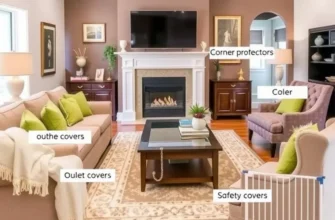Finding a rental apartment that accommodates not just families, but also their beloved exotic pets, can often feel like a daunting task. Many families are eager to expand their household with feathered, scaled, or furry friends, but securing a home that welcomes these unique animals requires extra consideration. As you search for the perfect location, understanding both your pet’s needs and the landlord’s regulations is crucial to ensuring a harmonious living environment. Families with pets want assurance that their new environment is safe, comfortable, and family-friendly. In this guide, we’ll explore practical tips and strategies for finding the right apartment that fits your family’s lifestyle while ensuring your exotic pets can thrive alongside you in your new home.
Understanding Your Pet’s Needs

Creating a comfortable living environment for exotic pets can be a rewarding challenge for families. Each species comes with unique requirements, which your chosen apartment must accommodate. Let’s explore the essentials for some commonly kept exotic pets to guide you in selecting the best space.
Reptiles:
Many reptiles, such as snakes and geckos, thrive in environments that mimic their natural habitats. Look for apartments that allow controlled temperature and humidity settings, as most reptiles are ectothermic. Access to natural light is beneficial, but for reptiles, having well-placed artificial lights that simulate natural conditions is crucial. Ensure the apartment’s electrical system can support any necessary equipment.
Birds:
Birds, like parrots or cockatiels, require ample space both horizontally and vertically. Select an apartment that can accommodate spacious cages, allowing birds to stretch their wings and move freely. Good ventilation is critical to maintain air quality, especially where birds generate dust and dander. Ensure that any balcony spaces are secure or can be bird-proofed if your feathered friend enjoys a taste of the outdoors.
Small Mammals:
For pets such as ferrets or hedgehogs, the need for exploration space is significant. Apartments with open layouts provide opportunities for play and exercise. Additionally, the flooring should be easy to clean and accommodate the use of pet-friendly carpets or mats to prevent accidents, which can be further explored through pet-friendly flooring solutions. Look for units that permit small modifications to cater to their burrowing or hiding tendencies.
Amphibians:
If you keep frogs or salamanders, remember they thrive in moist environments. Choose an apartment with easy access to water sources for frequent tank maintenance. Ensure the apartment can maintain stable temperatures, as amphibians are highly sensitive to fluctuations.
Invertebrates:
Spiders and insects are likely less demanding regarding space but require specific environments in their contained habitats. Stability and peace are crucial, which means looking for a quiet apartment setting or one that enables you to create a low-vibration environment.
When searching for the perfect apartment for your exotic pet, consider access to pet-related facilities and the landlord’s pet policy. Being upfront about your obligations and ensuring you meet the requirements can make your apartment search much less daunting. With these insights, you’ll not only accommodate your exotic companion’s needs but also ensure a harmonious living experience for all family members.
Finding Pet-Friendly Rentals

Searching for a rental that welcomes exotic pets with open arms extends beyond merely checking off a pet-friendly box on a rental listing. For families with unique companions such as reptiles, birds, or even miniature pigs, finding a place that is both suitable for the pets and satisfying to the family can be a significant hurdle. This chapter outlines practical steps to locate pet-friendly apartments, suggesting specific neighborhoods, utilizing online resources, and preparing inquiries for potential landlords.
Identify Suitable Neighborhoods
Living in an area that embraces a pet-friendly culture can significantly enhance your apartment-hunting experience. Cities like Boulder and neighborhoods in Pensacola have established reputations for being welcoming to tenants with pets. Exploring local pet-related forums or community groups can yield insights about the best areas suited for various pet needs. Choose neighborhoods that have pet amenities such as parks, pet stores, and veterinary clinics nearby. Some towns even have exotic animal clubs, giving your family the chance to socialize with other pet owners.
Leverage Online Resources
A wide array of resources has burgeoned to cater to the niche market of exotic pet-friendly rentals. Utilize online platforms that filter results based on pet policies rather than simply adding “pet-friendly” in the search query. Ensure to contact the landlords directly to confirm whether their definition of “pet-friendly” aligns with your needs. Specific sites offer advanced features allowing users to set parameters related to weight, breed, and type of pet, thereby streamlining your search process significantly. Consulting local rental guides, such as apartment insights specific to areas like Missoula, can provide focused information, enhancing the search for exotic pet rentals.
Ask the Right Questions
Being proactive in your search involves preparing a comprehensive list of questions to discuss with potential landlords. Inquire about any pet restrictions, additional security deposits, and modifications to the apartment that may be necessary for accommodating your exotic pet. For instance, some reptiles require specific heat and humidity settings—ensure that the apartment’s infrastructure can support these needs. Moreover, ascertain the landlord’s policy on potential damages and their responsibilities. This kind of clarity can prevent disagreements and provide peace of mind. More insights can be found in resources like landlord and tenant responsibilities.
A detailed discussion on pet insurance requirements and coverage for exotic pets can equally preempt misunderstandings. Preparing documentation or references that highlight your pet’s good behavior might persuade hesitant landlords.
By thoroughly researching neighborhoods, utilizing specialized online resources, and asking informed questions, you can secure a rental that lovingly accommodates the entire family, fur, feathers, scales, and all.
Final words
Renting an apartment that caters to both families and exotic pets can be a rewarding experience when approached with the right knowledge and preparation. Whether you’re considering an apartment with ample outdoor space for exploration or a cozy indoor environment for your unique animal companions, being informed about your pet’s needs and understanding how to communicate these needs to potential landlords will set you on the path to a successful move. Remember that countless families have successfully found homes that accommodate their furry, scaly, or feathered friends. By being proactive and using the tips outlined in this guide, you too can ensure a happy and harmonious living situation for your family and its beloved pets.









